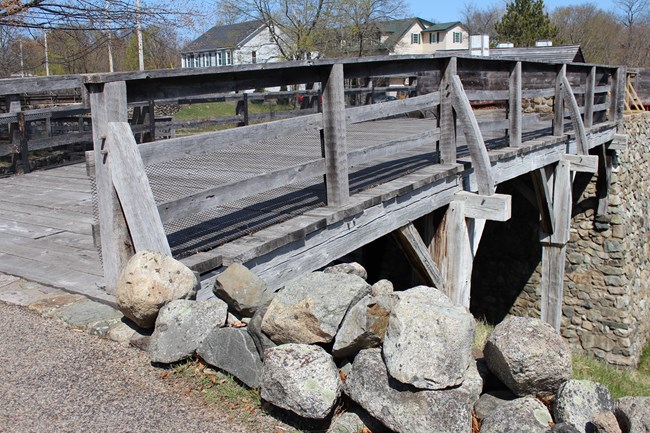Part of a series of articles titled Iron Making.
Previous: Iron Making: Introduction
Next: Iron Making: Casting
Article

NPS Photo / Elizabeth Thakkar
In 1646, the original blast furnace roared to life, lit with a 3000 degree fire that was kept burning 24 hours a day for months at a time. The blast furnace is where bog ore was smelted to create cast iron "pig" bars, so named because liquid cast iron was fed from a larger trench into smaller trenches as a mother sow to suckling pigs. To make cast iron, three raw materials were brought over the charging bridge and loaded into the chimney of the furnace.
Charcoal fueled a fire that burned hot enough to smelt the ore. Charcoal production was very labor intensive and required the work of many woodcutters, carters, and the colliers who oversaw the conversion of seasoned wood into charcoal.
Bog ore is an iron-rich sedimentary rock that was harvested locally from bogs and similar bodies of water. It was also found in fields and meadows that used to be bogs. Bog ore is often considerably less than 50% iron. The rest of the rock was made up of impurities that the workers had to remove.
Gabbro was used as a flux;a way to purify the ore. It was mined on nearby Nahant and transported up the Saugus River by boat.
A wood fire was started at the bottom of the furnace to dry out the mortar that was between the new lining stones and brick. Gradually at first, charcoal, iron ore, and gabbro were charged into the top of the furnace in layers by the furnace fillers. The "burden" as it was called, was carefully managed by the founder. The founder also was responsible for managing air flow from the bellows.
The burden was held in place above the crucible (where the molten iron was collected) at the bottom of the furnace by a narrowing of the furnace lining called the "boshes". Air was pumped into the furnace above the crucible but below the boshes.
Air, though invisible, was also a raw material and blew into the furnace using large, water-powered bellows. Oxygen in the air made the fire burn hot and (managed properly) created the appropriate conditions for carbon monoxide to remove oxygen from the iron ore. As the air passed upward through the burden, it first came across the charcoal. As the charcoal burned, the air converted to carbon monoxide. Carbon monoxide continued to rise upward. It latched onto the oxygen atoms in the ore and was carried further upward and out the furnace stack as carbon dioxide.
High heat that was generated by the fire caused the gabbro to melt and form a flux. Flux performed multiple functions. Since it melted at a lower temperature than the iron in the ore, it facilitated the flow of silicates and other impurities from the ore. The glassy flux also coated the iron as it melted. It formed a protective barrier between the liquid iron and the oxygen in the furnace gasses and prevented the iron from oxidizing away.
As a charge was transformed, the flux with its impurities descended past the boshes into the crucible. The liquid iron that was coated in flux trickled past the boshes, through the slag, and settled to the bottom of the crucible. The displaced liquid slag floated on top of the molten iron along with any unburned charcoal bits, ash, and other dross.
Iron was graded as gray, white, or mottled and was checked by fracture testing, that is, breaking the iron to visually inspect the way that carbon was interspersed through the cast iron. The crystallization that produced the various grades was deliberately controlled by the founder. With great knowledge and skill, he regulated ore, fuel, air, flux, and even cooling rate to create desired attributes in the iron.
Part of a series of articles titled Iron Making.
Previous: Iron Making: Introduction
Next: Iron Making: Casting
Last updated: August 26, 2021